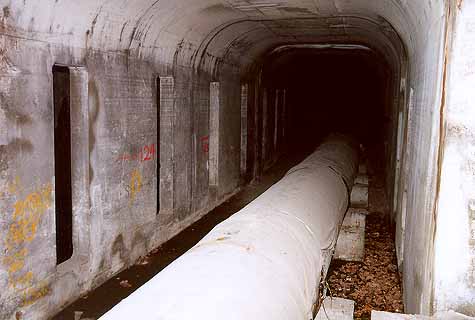
See Liberty St. Station section for more photos of the bomb shelter

In 1957 the city saved excavation costs when a high pressure 52" water main was run through the entire 2 mile length of the southbound tube. The pipe crosses to the opposite tube at the Race St. station. This main is still in operation today, and has been an obstacle to the many later proposals for the tunnel.
In the 1960's, the east platform and bathrooms of the Liberty St. station were converted into a nuclear fallout shelter. The shelter is in ruins today, and was not much of a shelter to begin with. The county claimed it was large enough for 300 people, however just eight bunks were placed in one of the station's bathrooms, and there was little other modification to the station, with the exception of an exhaust fan between the downtown and uptown platforms. The "shelter" is in no way sealed off from the the subway tubes, and since it is only a few feet below the surface to begin with, whatever protection it would have given was only marginally better than a home basement. Nevertheless, it was stocked with dozens of green 17.5 gallon water/sanitary waste canisters, which have been littered throughout the rest of the subway courtesy of vandals. Although it is gone today, the shelter also had radio gear, as well as a phone. Up until around 1990 this phone actually worked, and apparently tunnel vandals could make free calls. I have received several e-mails regarding the phone -- one claimed that a pizza was ordered, and another said a buddy called his girlfriend in Paris.

See Liberty
St. Station section for more photos of the bomb shelter
Also in the 60's, it is rumored that a psychedelic happening was held in the subway, however I have not been able to find any additional information on this, as far as how large of an event this was or what exactly took place (although we can make certain assumptions!).
Many other proposals for the tunnel were made as well. At one point investors sought to run freight trains through the tunnel, making deliveries to businesses along Central Parkway, however the curves proved too sharp for standard freight cars. A proposal was made in the 1950's for the tubes to be converted to automobile use, leading to a massive new riverfront parking lot. Of course, a 10 block tunnel extension through downtown would have been necessary for this to have been useful, which was the main reason why the subway wasn't put into operation originally. In the 1970's promoters sought to open a restaurant, night club, and wine cellar in the subway, however they could not get insurance, and the city would not move the water main. In the 1980's the University of Cincinnati proposed operation of an experimental wind tunnel in the subway. Also in the 80's, the subway was considered for a movie location, but once again the water main was a problem.
In late 1999 and early 2000, fiber optic cable was
installed
in the tunnel from the Plum St. turn to the north portals. The
cables
run through a pair of 6 inch diameter conduits along the roof of the
tube
without the water main.
Construction
Photos
Portal
Photos
Brighton
Station Photos
Linn
St. Station Photos
Liberty
St. Station Photos
Race
St. Station Photos
Hopple
St. Tunnel
Norwood
Tunnels
1950's
Photo Tour
Early
Subway Plans and Diagrams
Subway
Maps